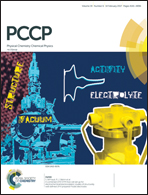Remarkable influence of ‘phane effect’ on the excited-state properties of cofacially oriented coumarins†
Abstract
A comprehensive investigation of the photophysics of a cofacially oriented bis-coumarin based on naphthalene, i.e., Cou-Nap, designed and synthesized to examine the influence of π-electronic communication between the two fluorophores, reveals exceptional excited-state properties. While the anticipated [2 + 2] photocycloaddition is not observed despite the fact that the two reactive coumarin units are at a distance of 3.8 Å, the fluorescence quantum yields and singlet lifetimes in different solvents are found to be remarkably higher when compared to those of the parent coumarin and a mono-coumarin model system, i.e., Cou-Dur. In addition to large solvent-induced Stokes shifts, Cou-Nap displays intriguing temperature-dependent emission in a nonpolar solvent such as cyclohexane. The observed photophysical properties are reconciled based on the so-called ‘phane effect’ that is operative in cyclophanes. In the latter, an effective π−π interaction between the aromatic rings modifies the attributes of the chromophore in such a manner that the observed properties cannot be associated with the individual aromatic rings. The temperature-dependent emission is proposed to arise as a consequence of thermally activated ISC from the singlet-excited state to one of the higher energy triplet states. The results constitute, for the first time, the demonstration of modification of the excited-state properties of a fluorophore in a non-cyclophane system by ‘phane effect’.



 Please wait while we load your content...
Please wait while we load your content...